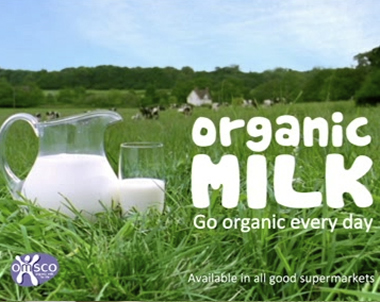
Wetter, cooler summers can have a detrimental effect on the milk we drink, according to new research published by Newcastle University.
Researchers found milk collected during a particularly poor UK summer and the following winter had significantly higher saturated fat content and far less beneficial fatty acids than in a more ’normal’
year.
But they also discovered that switching to organic milk could help overcome these problems. Organic supermarket milk showed higher levels of nutritionally beneficial fatty acids compared with ’ordinary’ milk regardless of the time of year or weather conditions.
The study, which is published in this month’s Journal of Dairy Science (January 2011), leads on from previous research undertaken nearly three years ago which looked at the difference between organic and conventional milk at its source - on the farms.
"We wanted to check if what we found on farms also applies to milk available in the shops," said Gillian Butler, who led the study.
"Surprisingly, the differences between organic and conventional milk were even more marked. Whereas on the farms the benefits of organic milk were proven in the summer but not the winter, in the supermarkets it is significantly better quality year round."
There was also greater consistency between organic suppliers, where the conventional milk brands were of variable quality.
"We were surprised to see obvious differences between the conventional brands, with the more expensive ones not necessarily better," said Mrs Butler. "Some brands - which promote their suppliers as wholesome and grazing on fresh pastures - actually sold milk that appeared to be from very intensive farms."
Low levels of omega-3 and polyunsaturated fatty acids were discovered in some of these brands, which are indicative of a diet low in fresh grass. These samples also showed evidence of the cows being supplemented with a saturated fat product derived from palm oil.
Mrs Butler puts the differences down to a lower reliance on grazing and fertiliser suppressing clover on conventional farms. "The results suggest greater uniformity of feeding practice on farms supplying organic milk since there were no brands which differed consistently in fat composition," she said. "This implies a fairly uniform approach to feeding practised across these suppliers."
Organic dairying standards prescribe a reliance on forage, especially grazing, and, in the absence of nitrogen fertiliser, tend to encourage swards of red and white clover, which have been shown to alter the fatty acid intake and composition of milk.
While protein, antioxidants, vitamins, minerals and some mono and polyunsaturated fatty acids in milk are considered beneficial, saturated fatty acids are believed to have a negative effect on human health.
"We’re always being told to cut down on the saturated fat we consume and switching to organic milk and dairy products provides a natural way to increase our intake of nutritionally desirable fatty acids, vitamins and antioxidants without increasing our intake of less desirable fatty acids," said Mrs Butler.
"By choosing organic milk you can cut saturated fats by 30-50 percent and still get the same intake of beneficial fatty acids, as the
omega-3 levels are higher but omega-6 is not, which helps to improve the crucial ratio between the two."
While undertaking their research into the differences between organic and conventional milk, the researchers discovered the surprising link between milk quality and our changing climate. Their results suggest that if we continue to have wetter, cooler summers then farmers may have to rethink their current dairy practices.
There was a considerable difference between the milk bought in the first sampling period (July 2006 and January 2007) and corresponding times a year later. The second set of samples, following a particularly wet summer in 2007, was higher in saturated fat and lower in beneficial fatty acids.
"We didn’t expect to find differences between the sampling periods,"
said Mrs Butler. "But this is likely to be down to the impact of the weather on availability and quality of forage."
In North East England, for example, the summer of 2007 was particularly wet, with approximately 30 per cent higher recorded rainfall and 12 per cent lower temperatures compared with 2006.
"These conditions may affect the cows’ behaviour, reducing grazing intake and milk output," said Mrs Butler. "Farmers also often increase supplementation with concentrated feeds or conserved forage to maintain milk yields in these conditions."
During the region’s main silage making period (late May until the end of July) rainfall in 2007 was three times higher than the previous year, which also made for poorer quality silage and therefore the need for greater supplementation to compensate in winter diets.
"If these weather patterns continue, both forage and dairy management will have to adapt to maintain current milk quality," said Mrs Butler. "The higher levels of beneficial fats in organic milk would more than compensate for the depression brought about by relatively poor weather conditions in the wet year."
The researchers, who are part of the University’s Nafferton Ecological Farming Group and its Human Nutrition Centre, looked at the quality of milk in supermarkets across North East England at varying times of year over a two-year period.
They concluded that organic brands of milk available in supermarkets are higher in beneficial fatty acids such as CLA and omega-3 fatty acids in summer (as in their previous research) and winter (where previous research showed that the difference in the winter was not as noticeable).
Emma Hockridge, head of policy at the Soil Association, said: "This groundbreaking research proves for the first time that people buying organic milk will be benefitting from the higher levels of beneficial fatty acids in organic milk through the whole year."
